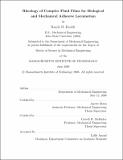| dc.contributor.advisor | Anette Hosoi and Gareth H. McKinley. | en_US |
| dc.contributor.author | Ewoldt, Randy H. (Randy Harold) | en_US |
| dc.contributor.other | Massachusetts Institute of Technology. Dept. of Mechanical Engineering. | en_US |
| dc.date.accessioned | 2007-05-16T15:22:36Z | |
| dc.date.available | 2007-05-16T15:22:36Z | |
| dc.date.copyright | 2006 | en_US |
| dc.date.issued | 2006 | en_US |
| dc.identifier.uri | http://hdl.handle.net/1721.1/36236 | |
| dc.description | Thesis (S.M.)--Massachusetts Institute of Technology, Dept. of Mechanical Engineering, 2006. | en_US |
| dc.description | This electronic version was submitted by the student author. The certified thesis is available in the Institute Archives and Special Collections. | en_US |
| dc.description | Includes bibliographical references (p. 137-143). | en_US |
| dc.description.abstract | Many gastropods, such as snails and slugs, crawl using adhesive locomotion, a technique that allows the organisms to climb walls and walk across ceilings. These animals stick to the crawling surface by excreting a thin layer of biopolymer mucin gel, known as pedal mucus, and their acrobatic ability is due in large part to the theological properties of this slime. The primary application of the present research is to enable a mechanical crawler to climb walls and walk across ceilings using adhesive locomotion. A properly selected slime simulant will enable a mechanical crawler to optimally perform while climbing in the horizontal, inclined, and inverted positions. To this end, the rheology of gastropod pedal mucus is examined in greater detail than any previously published work. The linear rheological response of pedal mucus is examined with flow, oscillation, and creep tests. Nonlinear rheology is examined with large amplitude oscillatory shear (LAOS), and analyzed with Lissajous curves, Fourier transform rheology, and a new measure of non-linear elasticity. In addition, pedal mucus is examined with a flexure-based microgap rheometer, which can test the sample at the biologically relevant gap of 10-20lim, the measured thickness of pedal mucus under a crawling slug. | en_US |
| dc.description.abstract | (Cont.) Adhesive locomotion of a mechanical crawler is modeled in order to find the criteria for an optimal slime simulant. After developing the selection criteria for the ideal simulant, a range of candidate materials are examined including polymeric gels, particulate gels, emulsions, composites, and field-responsive fluids. Two promising simulants are examined in detail and compared with native gastropod pedal mucus. | en_US |
| dc.description.statementofresponsibility | by Randy H. Ewoldt. | en_US |
| dc.format.extent | 143 p. | en_US |
| dc.language.iso | eng | en_US |
| dc.publisher | Massachusetts Institute of Technology | en_US |
| dc.rights | M.I.T. theses are protected by copyright. They may be viewed from this source for any purpose, but reproduction or distribution in any format is prohibited without written permission. See provided URL for inquiries about permission. | en_US |
| dc.rights.uri | http://dspace.mit.edu/handle/1721.1/7582 | |
| dc.subject | Mechanical Engineering. | en_US |
| dc.title | Rheology of complex fluid films for biological and mechanical adhesive locomotion | en_US |
| dc.type | Thesis | en_US |
| dc.description.degree | S.M. | en_US |
| dc.contributor.department | Massachusetts Institute of Technology. Department of Mechanical Engineering | en_US |
| dc.identifier.oclc | 77083789 | en_US |
